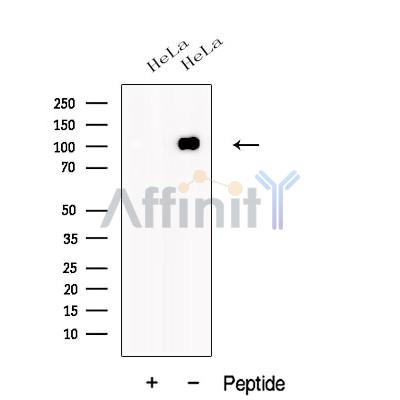AMOTL1 Antibody - #DF12556
| Product: | AMOTL1 Antibody |
| Catalog: | DF12556 |
| Description: | Rabbit polyclonal antibody to AMOTL1 |
| Application: | WB |
| Reactivity: | Human, Mouse, Rat |
| Prediction: | Pig, Horse, Rabbit, Dog |
| Mol.Wt.: | 107 kDa; 107kD(Calculated). |
| Uniprot: | Q8IY63 |
| RRID: | AB_2845518 |
Related Downloads
Protocols
Product Info
*The optimal dilutions should be determined by the end user.
*Tips:
WB: For western blot detection of denatured protein samples. IHC: For immunohistochemical detection of paraffin sections (IHC-p) or frozen sections (IHC-f) of tissue samples. IF/ICC: For immunofluorescence detection of cell samples. ELISA(peptide): For ELISA detection of antigenic peptide.
Cite Format: Affinity Biosciences Cat# DF12556, RRID:AB_2845518.
Fold/Unfold
2310010G08Rik; 2310067L22Rik; 4932416D09Rik; AMOL1_HUMAN; Amotl1; Angiomotin-like protein 1; FLJ00155; JEAP; Junction enriched and associated protein; mFLJ00155;
Immunogens
A synthesized peptide derived from human AMOTL1, corresponding to a region within C-terminal amino acids.
- Q8IY63 AMOL1_HUMAN:
- Protein BLAST With
- NCBI/
- ExPASy/
- Uniprot
MWRAKLRRGTCEPAVKGSPSACYSPSSPVQVLEDSTYFSPDFQLYSGRHETSALTVEATSSIREKVVEDPLCNFHSPNFLRISEVEMRGSEDAAAGTVLQRLIQEQLRYGTPTENMNLLAIQHQATGSAGPAHPTNNFSSTENLTQEDPQMVYQSARQEPQGQEHQVDNTVMEKQVRSTQPQQNNEELPTYEEAKAQSQFFRGQQQQQQQQGAVGHGYYMAGGTSQKSRTEGRPTVNRANSGQAHKDEALKELKQGHVRSLSERIMQLSLERNGAKQHLPGSGNGKGFKVGGGPSPAQPAGKVLDPRGPPPEYPFKTKQMMSPVSKTQEHGLFYGDQHPGMLHEMVKPYPAPQPVRTDVAVLRYQPPPEYGVTSRPCQLPFPSTMQQHSPMSSQTSSASGPLHSVSLPLPLPMALGAPQPPPAASPSQQLGPDAFAIVERAQQMVEILTEENRVLHQELQGYYDNADKLHKFEKELQRISEAYESLVKSTTKRESLDKAMRNKLEGEIRRLHDFNRDLRDRLETANRQLSSREYEGHEDKAAEGHYASQNKEFLKEKEKLEMELAAVRTASEDHRRHIEILDQALSNAQARVIKLEEELREKQAYVEKVEKLQQALTQLQSACEKREQMERRLRTWLERELDALRTQQKHGNGQPANMPEYNAPALLELVREKEERILALEADMTKWEQKYLEESTIRHFAMNAAATAAAERDTTIINHSRNGSYGESSLEAHIWQEEEEVVQANRRCQDMEYTIKNLHAKIIEKDAMIKVLQQRSRKDAGKTDSSSLRPARSVPSIAAATGTHSRQTSLTSSQLAEEKKEEKTWKGSIGLLLGKEHHEHASAPLLPPPPTSALSSIASTTAASSAHAKTGSKDSSTQTDKSAELFWPSMASLPSRGRLSTTPAHSPVLKHPAAKGTAEKLENSPGHGKSPDHRGRVSSLLHKPEFPDGEMMEVLI
Predictions
Score>80(red) has high confidence and is suggested to be used for WB detection. *The prediction model is mainly based on the alignment of immunogen sequences, the results are for reference only, not as the basis of quality assurance.
High(score>80) Medium(80>score>50) Low(score<50) No confidence
Research Backgrounds
Inhibits the Wnt/beta-catenin signaling pathway, probably by recruiting CTNNB1 to recycling endosomes and hence preventing its translocation to the nucleus.
Polyubiquitinated by NEDD4, leading to proteasomal degradation.
Cell junction>Tight junction.
Belongs to the angiomotin family.
Research Fields
· Cellular Processes > Cellular community - eukaryotes > Tight junction. (View pathway)
Restrictive clause
Affinity Biosciences tests all products strictly. Citations are provided as a resource for additional applications that have not been validated by Affinity Biosciences. Please choose the appropriate format for each application and consult Materials and Methods sections for additional details about the use of any product in these publications.
For Research Use Only.
Not for use in diagnostic or therapeutic procedures. Not for resale. Not for distribution without written consent. Affinity Biosciences will not be held responsible for patent infringement or other violations that may occur with the use of our products. Affinity Biosciences, Affinity Biosciences Logo and all other trademarks are the property of Affinity Biosciences LTD.
